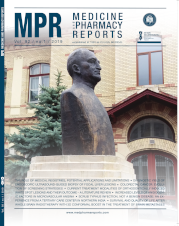Factors influencing extracorporeal shockwave lithotripsy efficiency in the management of lower pole stones
DOI:
https://doi.org/10.15386/mpr-2913Keywords:
extracorporeal shockwave lithotripsy, lower pole stone, double J stent, urolithiasisAbstract
Objectives. The low efficacy of extracorporeal shock wave lithotripsy (ESWL) in the treatment of lower pole stones is well known; the parameters which influence this effect are still under debate: patient age, stone size, presence of double J stent, body mass index (BMI), and radiological parameters of the lower calyx, such as infundibulopelvic angle (IPA), infundibulum length (IL), and width (IW) of patients and the skin-stone size.
Methods. We studied the effectiveness of extracorporeal shock wave lithotripsy (ESWL) in the treatment of lower calyx stones. All patients were investigated by uro- CT or intravenous urography (IVU), or kidney, ureter, bladder (KUB) radiography to confirm the diagnosis. J stents were inserted before therapy in 64 (18.6%) renal units. Factors affecting success, stone-free rate and complications were analyzed. We measured the skin-stone distance (SSD) of the lower calyx on 39 uro-CT image data, and infundibulum length, width and infundibulopelvic angle on 31 intravenous urography (IVU).
Results. Our retrospective study (between 2021 and 2024) included a total of 344 patients who underwent ESWL for lower calyceal stone (172 men, 172 women) with an average stone size 9.093±2.829 mm. 68.605% of patients became stone-free after the first ESWL session. The average skin stone distances measured in 0°, 45°, 90° angles were 96.5 ± 24.92 mm. Using the Chi-square test, we concluded that previously stented patients had a statistically lower stone-free rate (SFR) than those without a stent. (p=0.0078). The body mass index (BMI) of patients also influenced the SFR, as calculated with an Unpaired t-test and Welch correction (p = 0.002). We did not find any statistically significant differences between skin-stone sizes of patients with or without successful stone fragmentation (p=0.1147), and infundibulum length (p=0.07), infundibulum width (p=0.7681), and infundibulopelvic angle (p=0.996).
Conclusions. Single ESWL sessions often fail to achieve stone fragmentation and elimination, as this study shows. The success of ESWL sessions can be affected by the anatomical position of the stone, a lower pole kidney stone, the presence of pre-procedural double J stenting, and obesity.
Downloads
Published
How to Cite
Issue
Section
License
Copyright (c) 2025 Dóra-Andrea Miheler, Tibor Reman, Raul Gherasim, Olivér A. Vida, Daniel Porav-Hodade, Orsolya Mártha
The authors are required to transfer the copyright of the published paper to the journal. This is done by agreeing to sign the Copyright Assignment Form. Whenever the case, authors are also required to send permissions to reproduce material (such as illustrations) from the copyright holder.

The papers published in the journal are licensed under a Creative Commons Attribution-NonCommercial-NoDerivatives 4.0 International License.

